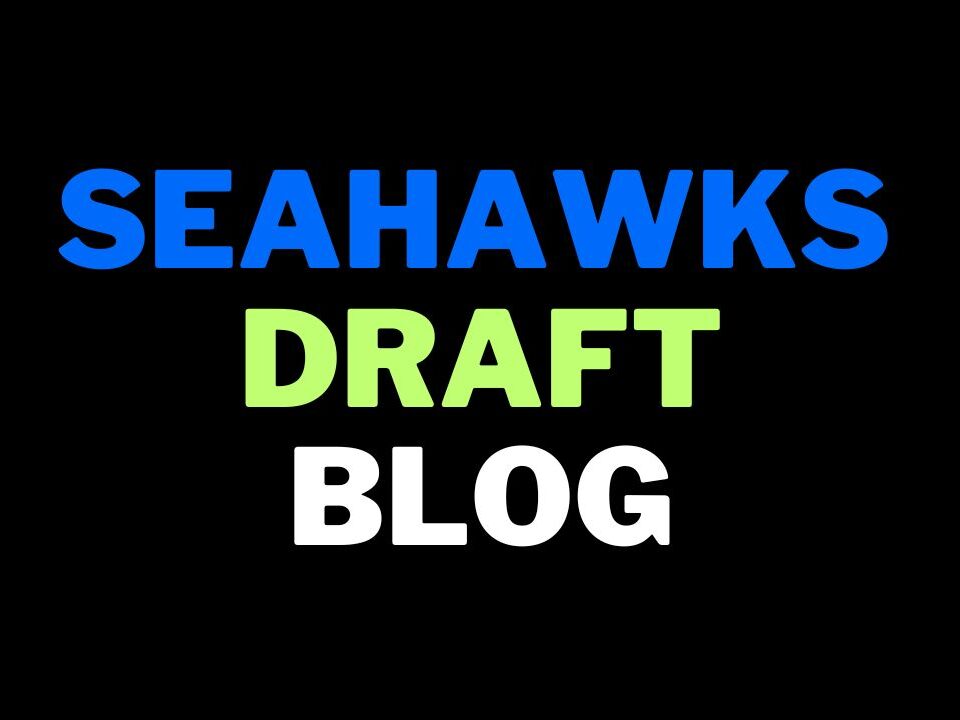
This is what a Seahawks receiver looks like after catching a football
Some interesting numbers from Advanced NFL Stats…
– Sidney Rice, earning $8.2m in 2012, has been targeted 15 times in three games. That’s good enough for 58th in NFL receivers, behind Andrew Hawkins, Michael Jenkins and Dexter McCluster. Rice has caught eight of those passes, 40% of which are considered downfield attempts.
– Golden Tate is 7oth on the list with 11 targets but missed the opening game against Arizona. 55% of his targets have been downfield throws, second highest in the NFL.
– Braylon Edwards has nine targets with five catches. Not a single one of those targets was considered a downfield throw.
– Only two tight ends have seen less targets than Zach Miller and Anthony McCoy (both thrown at eight times). In comparison, Jeff Cumberland of the New York Jets has 15 targets.
– Russell Wilson has attempted 75 passes, less than every active quarterback in the NFL not named Kevin Kolb or John Skelton. The two Arizona quarterbacks combined have thrown nine more passes than Wilson.
– Only one running back has rushed more times than Marshawn Lynch – Houston Adrian Foster. Lynch (72 carries) and Foster (79 carries) are well clear of the chasing pack. Third most active running back – Doug Martin – has 63 carries. Maurice Jones-Drew is fourth with 59 carries.
Conclusion: How can we judge if this quarterback and group of receivers are good enough if the passing game is taking such an exaggerated back seat to the running game?
I ask this question only because people are either a.) saying Seattle’s greatest need is at receiver and b.) that it’s time for Matt Flynn to start at quarterback. I’ve made the point about receivers myself, but I’m starting to question it. How can we come to that conclusion on such little evidence? Likewise, I’m not sure what you expect to see from Flynn in such an unbalanced offense?
Let’s start with the receivers.
In 2009 Sidney Rice was 4th in the NFL for receiving yards and yards per game. Only Andre Johnson, Wes Welker and Miles Austin were ranked higher. Sure, the Vikings had the good version of Brett Favre that year. But Rice, when healthy, showed he can be a truly effective NFL receiver. He was a big-play threat too, with only Vincent Jackson and Robert Meachem earning a higher yards per target average. Nobody has ever questioned Rice’s quality, just his ability to stay healthy. Considering he’ll earn $9.7m in both 2013 and 2014, the team will need to feel he’s having a big enough impact to justify that salary. When he signed the deal, Pete Carroll and/or John Schneider clearly felt he could be a defining piece of the offense.
Zach Miller’s cap hit in 2012 is $7m and it’ll rise to a humongous $11m in 2013. By the end of the 2012 season Miller will have cost the Seahawks $10m. Another way of looking at it is $1m per three catches and zero touchdowns. He’s played 18 games, most of which he’s acted as a third offensive tackle. Before he moved to Seattle, he was Oakland’s top receiver by some distance in 2008, 2009 and 2010. Again, when he signed the deal, Pete Carroll and/or John Schneider clearly felt he could be a defining piece of the offense.
Golden Tate has cost Seattle just $2.06m in salary to date, with the final year of his rookie contract worth $880k in 2013. He also cost the Seahawks an important second round pick in the 2010 draft – Carroll and Schneider’s first with the team. Interesting fact – had the Seahawks not traded for Charlie Whitehurst, they would’ve had the opportunity to draft Rob Gronkowski, Jimmy Graham or Aaron Hernandez. Even with the Whitehurst trade, they had a shot at Graham and Hernandez. Tate has so far produced five career touchdowns for the Seahawks, 13 less than Graham and Hernandez combined for in 2011 alone. Not that anyone expected Tate to produce similar numbers, but people perhaps expected more than they’ve seen so far. After all, he won the Biletnikoff Award at Notre Dame as the nations top college receiver and accumulated 25 receiving touchdowns in 2008 & 2009. The team lacked playmakers in 2010 and Seattle’s front office clearly believed Tate could change that.
The point I’m getting at here is, these guys have proven production. In the case of Rice and Miller, it’s proven NFL production. Throw in the promise of Doug Baldwin and Anthony McCoy and this should be a group that you feel comfortable with. Sure, there isn’t the superstar high draft pick who legitimises a unit by reputation alone. Yet there should be enough talent to at least form the basis of a decent passing offense. This isn’t the Cleveland Browns where finding legitimate receivers is beyond a crucial need. It’s just in Seattle, these guys aren’t getting a chance to really show what they can do.
I would argue it’s the same situation at quarterback. Robert Griffin III (+14), Ryan Tannehill (+27), Brandon Weeden (+40) and Andrew Luck (+47) all have more passing attempts than fellow rookie Russell Wilson. Pete Carroll has admitted he’s trying to limit turnovers at the moment and I believe him when he says it’d be the same situation for Matt Flynn. It’s not an individual issue at the quarterback position – it’s a scheme decision. It’s worth noting that Seattle has a better record than Griffin’s Redskins, Tannehill’s Dolphins, Weeden’s Browns and Luck’s Colts. Tannehill, Weeden and Luck have combined for 14 interceptions in three games. Griffin III and Wilson – the two quarterbacks with much less passing attempts – have combined for just two interceptions. Coincidence? Or smart coaching?
The team wants to run the ball and limit turnovers – there’s no secret there. They are very happy right now to play field position, great defense and hope for one or two big plays to compliment the run game. If the defense can hold a powerhouse offense like Green Bay to twelve points and a decent Cowboys outfit to seven, it might not be the worst plan in the world at home. Yet when Wilson has been challenged he’s looked very sharp. For all the little errors we’ve seen (to be expected from a rookie) we’ve also seen three glorious looking touchdown passes to Rice (Arizona), McCoy (Dallas) and Tate (Green Bay – and not THAT touchdown pass).
We look at the list of eligible 2013 receivers and wonder whether a guy like Justin Hunter, Cordarrelle Patterson or Keenan Allen could become a #1 target for Wilson – but what’s the point in making that investment if the team is throwing 15 passes at a guy earning $8.2m this year? We look at guys like Robert Woods and Tavon Austin and wonder if they could be the teams answer to Wes Welker or Percy Harvin, but are they going to have an impact if you’re not going to put the ball in their hands?
Perhaps a time will come in the future when they feel confident to allow Wilson to let it rip? Maybe that day will come soon, but this is a regime that has consistently delivered bad numbers at the quarterback position. In 2010 Matt Hasselbeck was 21st for passing yards but delivered an ugly looking 12-17 touchdown-to-interception ratio. His QB rating was only higher than the bad version of Brett Favre, Derek Anderson and Jimmy Clausen. In 2011 Tarvaris Jackson had just 14 touchdowns – as many as Colt McCoy and twelve less than Mark Sanchez. He had a QB rating worse than Kevin Kolb. Ryan Fitzpatrick had over 700 more passing yards than Jackson and more touchdowns, but he also turned it over many more times. More than anything, they wanted Jackson to secure the football – something Hasselbeck struggled to do in 2010.
Now Russell Wilson is near the bottom of the same lists. There are some positives because he’s not turning it over, but he’s also showing numbers that belittle all the pre-season hype that built up around the NFL – not just in Seattle. With good reason too – he was superb. It’s a bit like leaving a great car in the garage and then patting yourself on the back because it looks brand new. On the one hand, you have a perfectly unblemished motor vehicle. That’s cool. You’re not lying when you boast about it. But nobody ever sees you driving the thing, so people wonder ‘what’s the point’?
The whole situation is being masked by a 2-1 record right now and rightly fans should be satisfied with that. Maybe the Seahawks go into St. Louis and Carolina and out fight their opponents before returning to Seattle with a fantastic 4-1 record? Who the heck is going to complain then if Russell Wilson throws barely over 100 yards in each game?
Then there’s the other side of the coin. What if the Seahawks face a situation like the Arizona game? A closely fought contest on the road ending in defeat because when the game was on the line, they couldn’t throw the ball into the end zone? This could become more of an issue very quickly. In fact, had Seattle not been awarded a favorable decision on Monday, it would probably be the big talking point in the local media this week and not ‘that catch’.
An unbalanced offense is easy to accept while the team is winning. If that continues, nobody will question anything. Go ‘Hawks! But a risk-free strategy still carries an element of risk. I think back to Rice in 2009, or Tate at Notre Dame, or Wilson in pre-season and wonder… can we turn this on like a tap when needed? Are we making the most of some talented skill players? And can we properly judge them in this current form of a Seahawks offense? Right now I’m not sure how we can judge this quarterback or group of receivers. They’re still in the original packaging.





